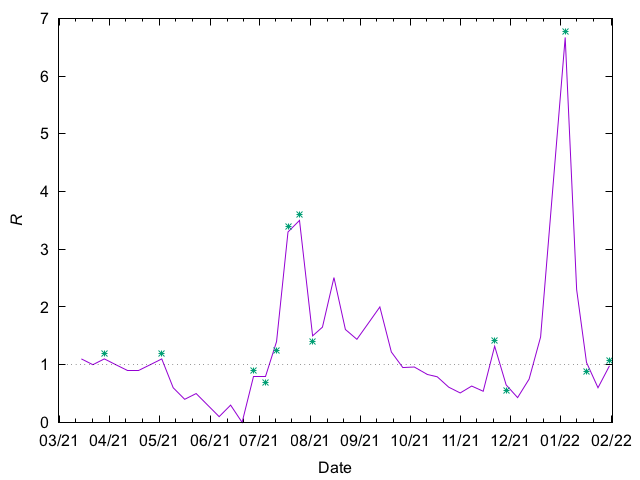My third textbook, Foundations of Chemical Kinetics: A Hands-On Approach, was just published a few weeks ago. (The link in the previous sentence will be convenient if your institution has a subscription to the IOP books. If you want to buy a copy, try https://store.ioppublishing.org/page/detail/Foundations-of-Chemical-Kinetics/?K=9780750353199. And if you’re thinking of adopting this book in one of your courses, the latter page also contains a link to order an inspection copy.) The publication of this book caused me to start thinking about the very different ways my three books have come about. Those of you thinking of writing a book, or just curious about the book writing process, may want to continue reading. Otherwise, you can wait for the next installment in this increasingly irregular blog.
When I arrived at the University of Lethbridge, I was handed the second-year thermodynamics course as one of my teaching assignments. When choosing the textbook for this course, I made the proverbial rookie mistake: I picked a book I liked, forgetting that the book is for the students, and not for me. Among other things I didn’t think about were: What background do the students bring to this class? What are their likely scientific interests? And of course, how might my perspective differ from that of a student taking their first steps in themodynamics? I won’t say what book I picked because these were my mistakes and not the author’s. Let’s just say that I picked a book that would have been great for students in a specialist program with more of a mathematics background than is required of the group of Chemistry and Biochemistry students in my class.
Once I realized my mistake, I started looking more seriously at the range of physical chemistry textbooks on the market. I was looking for a book that was approachable, that included some biochemical topics (because the majority of the students in the course were Biochemistry majors), but that still didn’t compromise too much on rigor. I wanted students to understand the principles of thermodynamics, and not just learn some formulas and how to apply them. I eventually settled on Tinoco, Sauer and Wang’s Physical Chemistry: Principles and Applications in Biological Sciences, an excellent book that, I thought, struck roughly the right balance. TSW was the required textbook in my thermo course for about three years.
I honestly don’t remember exactly when I decided to write my own book. I do remember thinking that what I was writing was a set of course notes, and that I needed to write these because Tinoco, Sauer and Wang didn’t go into quite enough depth on some topics that I thought were important. The idea that this could be a publishable book didn’t enter my head for quite a while. From the time stamps on the files, it looks like I started writing sometime during my first term of teaching in the Fall of 1995. By the Spring of 1998, the third time I taught the course, I had written a set of notes titled Practical Thermodynamics that I distributed through the UofL bookstore and that was offered to students as a supplement to Tinoco, Sauer and Wang. By the Fall of 1999, the roles were reversed: my book was required and Tinoco, Sauer and Wang was recommended. By the Fall of 2001, I had stopped recommending a second textbook.
In the meantime, I had also started teaching our chemical kinetics course, which was also a second-year offering. I used Tinoco, Sauer and Wang in Spring 2000, when I first took over the course, then switched to Laidler and Meiser’s Physical Chemistry the next year. (Laidler was a kineticist, so it shouldn’t be a great surprise that the kinetics in his physical chemistry textbook is excellent.) By 2002 I was distributing a self-written textbook through the bookstore entitled Chemical Kinetics, and not requiring a traditional textbook.
Once in a while, academics will decide to shake up a curriculum. We went through this process in the mid-2000s in order to try to sort out some problems we were having delivering our courses. In a nutshell: too many required courses, which didn’t give us a lot of flexibility in terms of teaching assignments and could be a problem when people were not available. One of the results of this curricular shakeup was the merging of the thermodynamics and kinetics courses. While this wasn’t exactly a do-over for me, it did require a lot of work to rearrange what I had, jettisoning about half of the material, resulting in something more-or-less like the book that was eventually published.
By this time, what I had was clearly a textbook. Not only did I have carefully constructed text laying out the ideas and key equations, but I had a large collection of problems from assignments and tests which I had been integrating into the book over the years. Sometime in 2009, I started looking for a publisher. One of the publishers I contacted was Cambridge University Press. Some decades earlier, they had published Morris’s A Biologist’s Physical Chemistry, a book that I thought had a lot in common with mine. Much to my delight, Cambridge agreed to be my publisher. They provided lots of support and advice along the way. The final version of the book was sent to Cambridge in May 2011.
I started working on the book (although I didn’t know it at the time) in 1995 and was done in 2011. There was progress on this book every year during that period, albeit not always at the same intensity. You can think of A Life Scientist’s Guide to Physical Chemistry as a book written at an adagisimmo tempo over a period of 16 years.
This book also started out as a set of lecture notes, in this case for a graduate course in nonlinear dynamics that I first taught in 2004, with a second offering in 2005. These notes were posted to my web site, where they still live. And that’s where they sat for a long time.
In 2018, I received an email from Nicki Dennis, who at the time was an acquisitions editor for the Institute of Physics (IOP) Concise Physics series. Nicki had somehow run across the lecture slides (just slides, not notes) for my Foundations of Chemical Kinetics course on my web site, a course that had been offered just once, in 2012. (At small universities, what you teach and when you teach it has more to do with what the Department and the students need than with what might be optimal for the instructor. Advanced courses in particular can be taught at very long intervals.) She thought I might want to turn this course into a book. I didn’t say no, but I knew that turning the Foundations course into a book would be a lot of work, especially since I was keen to revise the course after offering it once. As I always tell junior faculty members, the second time you offer a course is often when you put the most work into it because by then, you actually know what you want to do. Getting back to the story, I didn’t say no, but I didn’t say yes. Instead, I pitched Nicki the idea that I would turn my nonlinear dynamics lecture notes into a book, and that we could talk about the Foundations of Chemical Kinetics book later. Nicki and the IOP agreed, and I got to work revising my notes and turning them into a short book. That process took a very short time. I added some examples to my notes, expanded the treatment in a few places, converted assignments from the course into problem sections in the book, and in just a few months I was done.
You can think of this one as a stop-and-start (staccato) time investment, with each period of work on the book lasting just a few months. So a book produced andante, even though there is a long period from the first time I set fingers to keyboard to the completion of the manuscript.
In May 2021, I received an email from John Navas at the IOP, who mentioned the possibility of a new edition of the nonlinear dynamics book. I took this as an opportunity to bring up the kinetics book again, since I was going to be teaching my Foundations course the following Fall term. I had in mind a complete reworking of the course with, as the title of the book suggests, more hands-on instruction and exercises than existing textbooks in the area provided. So my utterly daft plan was to write the book as the course was unfolding (with some work done in the summer to get ahead of the lectures). I would feed the chapters to the students as they were completed.
If you’ve ever taken a single-term University course, you will know that the term goes by quickly. It feels even faster for the course instructor, and not just because we’re older. The students quickly caught up to the little bit of a head start I had built up in the summer, and then the chapters were coming out just before we covered the material in class, and eventually a little bit after. But I got through it! The result of this initial round of writing was, as you can imagine, not very polished, but over a few months, I cleaned it up, and now it’s out into the world!
Definitely a book written at a presto tempo. Perhaps even vivace. I’m not sure I would recommend writing a book this way to anyone else. But it’s doable, provided you allow a few months afterwards to clean up your first draft.
Some reflections
I’m sure there are many other ways to write books, but these three definitely span the range of timescales over which one might write something worth reading: slowly refined over many years, written and refined over multiple short bursts, or the strike while the iron is hot approach of Foundations in Chemical Kinetics. In the end, I think that there are a few keys to writing a book that all of these different scenarios share:
- You won’t write anything if you don’t actually sit down and start typing. Perhaps you don’t even intend to write a book, but anything you type and preserve is potentially material for a book, even if it’s just a set of lecture slides, or some original problems that you designed for your students.
- It may not be when you first start out, but you eventually need to develop a clear concept of the book, who it’s for, what approach you will take, and the style you intend to use. My books tend to use an informal style and, as the titles of my two most recent books suggest, to include a fair bit of hands-on practice. I’m particularly keen on teaching students computing skills which, weirdly at this point in the 21st century, is often a neglected dimension of their educations. Both the Nonlinear Dynamics and Foundations of Chemical Kinetics books include instruction in some general computational skills (e.g. programming in Matlab/Octave or symbolic computing in Maple) and some instruction in discipline-specific software (Xppaut in one case, Gaussian in the other).
- At some point, you need to decide that you’re ready to crank out a book. When you contact a publisher, they’re looking for something they can publish sooner rather than later. At that point, you need to be able to set time aside to meet mutually agreed deadlines. The more is already done, the better shape you will be in to deliver. And note that they will generally want to see sample chapters before they offer you a contract, unless they already have a relationship with you.
- There are going to be some long nights, no matter what your starting point.

